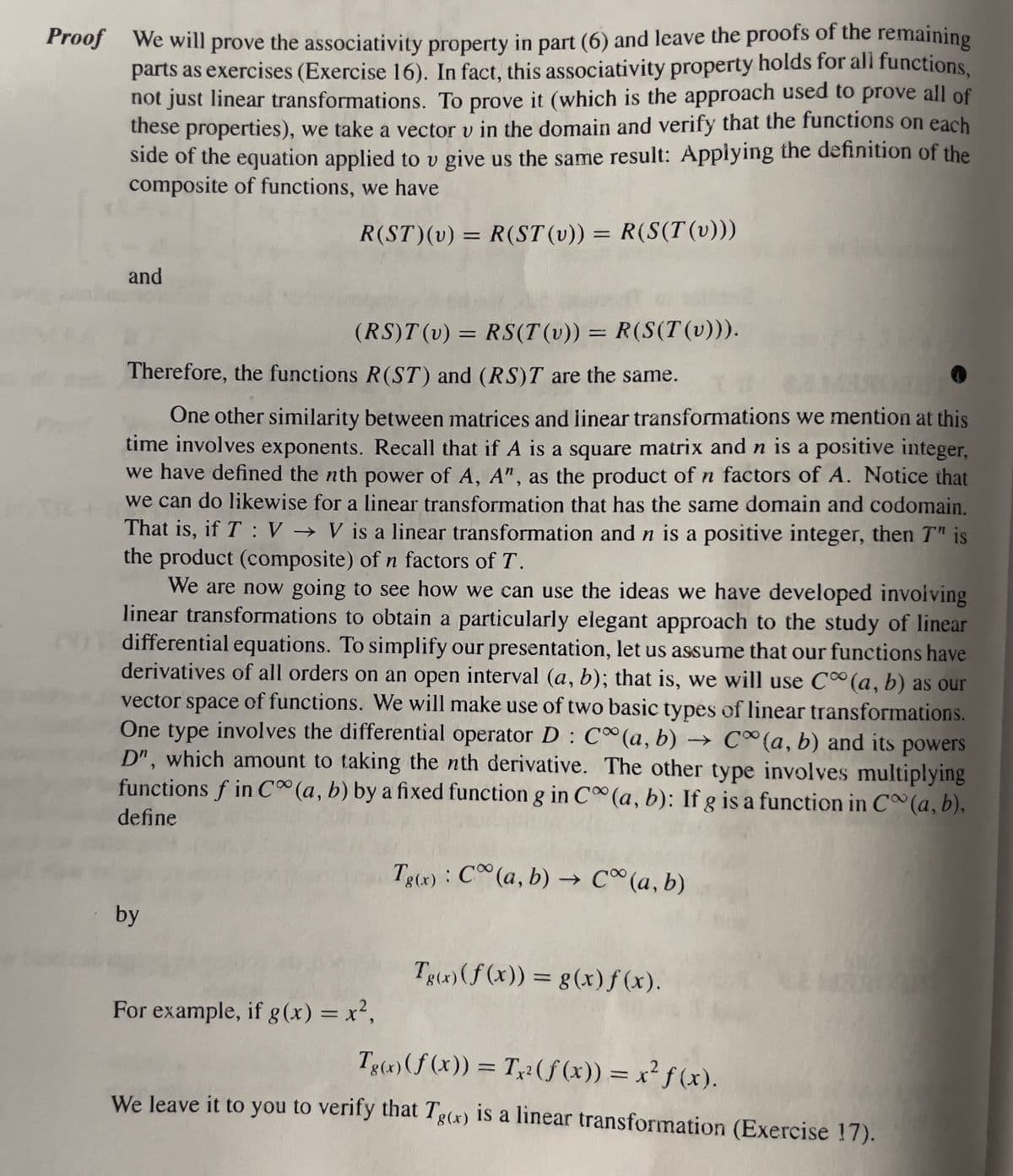17. Show that if g is a function in C transformation from C a linear (a, b), then Tg(x) is (a, b) to C (a, b).
17. Show that if g is a function in C transformation from C a linear (a, b), then Tg(x) is (a, b) to C (a, b).
Elementary Linear Algebra (MindTap Course List)
8th Edition
ISBN:9781305658004
Author:Ron Larson
Publisher:Ron Larson
Chapter7: Eigenvalues And Eigenvectors
Section7.CM: Cumulative Review
Problem 5CM: Find the kernel of the linear transformation T:R4R4, T(x1,x2,x3,x4)=(x1x2,x2x1,0,x3+x4).
Related questions
Question
PLEASE write it on PAPER.

Transcribed Image Text:17. Show that if g is a function in C (a, b), then Tg(x) is
a linear transformation from C(a, b) to C (a, b).

Transcribed Image Text:Proof We will prove the associativity property in part (6) and leave the proofs of the remaining
parts as exercises (Exercise 16). In fact, this associativity property holds for all functions,
not just linear transformations. To prove it (which is the approach used to prove all of
these properties), we take a vector v in the domain and verify that the functions on each
side of the equation applied to v give us the same result: Applying the definition of the
composite of functions, we have
R(ST)(v) = R(ST (v)) = R(S(T(v)))
and
(RS)T(v) = RS(T(v)) = R(S(T(v))).
Therefore, the functions R(ST) and (RS)T are the same.
UTOLE
One other similarity between matrices and linear transformations we mention at this
time involves exponents. Recall that if A is a square matrix and n is a positive integer,
we have defined the nth power of A, A", as the product of n factors of A. Notice that
we can do likewise for a linear transformation that has the same domain and codomain.
That is, if T: V → V is a linear transformation and n is a positive integer, then 7" is
the product (composite) of n factors of T.
We are now going to see how we can use the ideas we have developed involving
linear transformations to obtain a particularly elegant approach to the study of linear
differential equations. To simplify our presentation, let us assume that our functions have
derivatives of all orders on an open interval (a, b); that is, we will use C (a, b) as our
vector space of functions. We will make use of two basic types of linear transformations.
One type involves the differential operator D C (a, b) → C (a, b) and its powers
D", which amount to taking the nth derivative. The other type involves multiplying
functions f in C (a, b) by a fixed function g in C (a, b): If g is a function in C (a, b),
define
by
For example, if g(x) = x²,
Tg(x): C (a, b) → Co (a, b)
Tgix) (f(x)) = g(x)f(x).
Tg(x) (f(x)) = T₂²(f(x)) = x² f(x).
We leave it to you to verify that Tg(x) is a linear transformation (Exercise 17).
Expert Solution
This question has been solved!
Explore an expertly crafted, step-by-step solution for a thorough understanding of key concepts.
Step by step
Solved in 2 steps with 2 images

Recommended textbooks for you

Elementary Linear Algebra (MindTap Course List)
Algebra
ISBN:
9781305658004
Author:
Ron Larson
Publisher:
Cengage Learning

Linear Algebra: A Modern Introduction
Algebra
ISBN:
9781285463247
Author:
David Poole
Publisher:
Cengage Learning

Elementary Linear Algebra (MindTap Course List)
Algebra
ISBN:
9781305658004
Author:
Ron Larson
Publisher:
Cengage Learning

Linear Algebra: A Modern Introduction
Algebra
ISBN:
9781285463247
Author:
David Poole
Publisher:
Cengage Learning